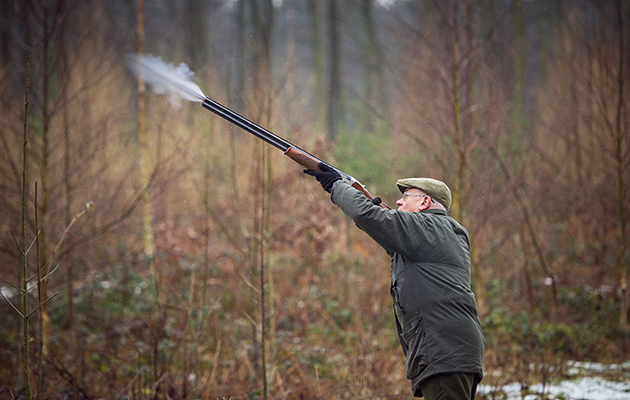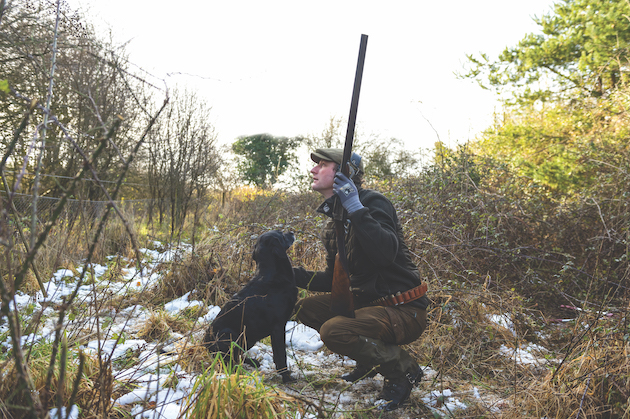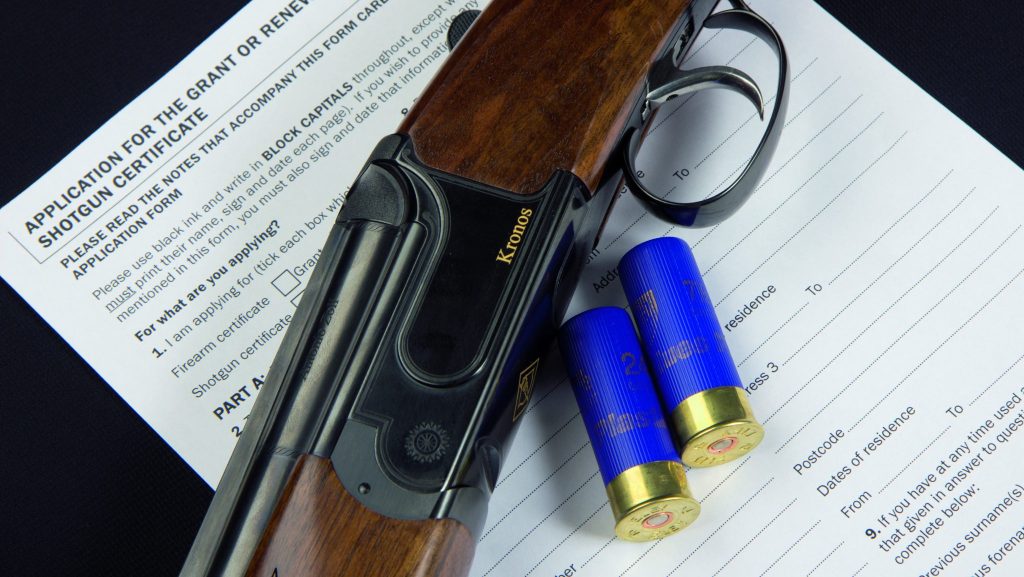Just how long does it take to receive or renew a shotgun licence or firearms certificate these days? BASC recently…
Win CENS ProFlex DX5 earplugs worth £1,149 – enter here
What exactly goes on in a police firearms licensing department?
 Man and gun
Usd 4 nov 15 vintage times
Man and gun
Usd 4 nov 15 vintage times
With about 23,000 certificate holders, Hampshire is a middling size force as far as firearms licensing is concerned. Its performance in recent years has left much to be desired. At one stage things were so poor that the force made an apology on Radio Solent. That’s the down side. The upside is that the force has been very open about its problems and has sustained a frank and transparent dialogue with the main shooting organisations through six monthly meetings.
Invitation to visit the firearms licensing department
It’s not often that forces will offer a warts-and-all invitation to visit their firearms licensing department and see what goes on behind the scenes. When Hampshire made the invitation, Sporting Gun was quick to accept. I spent a morning talking to Tony Hill, the firearms licensing manager, and Chief Inspector Darren Miller, who has been helping the Department as change manager. Tony has delegated authority for revocations and refusals and reports direct to Chief Superintendent Dave Powell. In some forces there is a long management chain which tends to blur where real responsibility lies, but not so in Winchester.
7 Deadly Sins: how to lose your shotgun certificate
How pride, envy, wrath, sloth, greed, gluttony or lust can lose you your shotgun certificate and firearms licence.
Why past poor performance?
I asked why things had gone wrong in the first place. Darren said it was a long gradual process, mainly resulting from most of the work being done on paper when everything else in the force was becoming digital.
- There were barely enough staff to carry out the daily work and certainly not enough to think through and implement improvements.
- The endless tinkering with firearms law and procedures, which has taken place in recent years, has created a steady increase in the workload.
- The paper system made it very difficult for management to know what was going on and to monitor the work and workload of the staff.
- The problem was compounded by an inevitable element of “we’ve always done it this way”.
- Many processes were being applied uniformly to everyone.
- No attempt was being made to identify and manage the potential risk.
- Applicants about whom there were no questions were getting the same time consuming treatment as the marginal cases.
- All forces have now adopted the National Decision Making Model, which Tony and his team use because it enables a risk management based approach to be taken to all decision making.
Digital
A major change was to transfer all the certificate holder records to Hampshire’s Record Management System (RMS). This is a force-wide, fully digitised, system of record handling covering all force activities. Unfortunately it is not possible to integrate it with the National Firearms Licensing Management System, which is regarded by the Home Office as legacy software and is not without shortcomings. RMS is used for the day-to-day handling of the licensing department’s business. Its adoption was a significant shift in the operating model. Darren explained that it was a huge piece of work to get the holders onto the system and it took about three months. The few remaining paper records are being transferred as certificates need to be renewed.

Hampshire police now use a force-wide, fully digitised system and paperwork is now kept to a minimum
Laptop access
Previously the paper files had to be moved around the people who needed to see them and in some cases this could take up to a fortnight. Now with everything being done digitally, firearms enquiry officers (FEO) are able to access the information they need from their laptops. The system also means that if a certificate holder comes to the attention of the police, all the key personnel will know. This enables the force to comply with an important recommendation in the Inspectorate of Constabulary’s 2015 report into licensing. I was surprised to hear that there are about 40 “hits” per day. Many are trivial such as the certificate holder being witness to a traffic accident, but about 25 each month require further investigation.
Despite these changes, the workload was building up and priority was given to renewals at the expense of grants. Eventually the department stopped going backwards but there was still a big backlog, which could not be cleared until the underlying system had been made right. A legacy system was instituted from 12th December 2016 to deal with the backlog, but all grant applications after that date are dealt with straight away. That’s bad news for those still in the legacy pipeline but Tony promises a much better service in the future.
Process
- We looked at what happens when you apply for the grant or renewal of a certificate.
- The application form can be filled in online but then has to be printed so that it can be signed (a legal requirement) and sent to the licensing department. “This is nuts”, says Darren, “because the first thing we do is to scan it and put it online”.
- The force is encouraging online payment through World Pay. With cheques and postal orders, a member of staff had to visit the bank once or twice a week to get them cashed, which was very time consuming. That’s now done by the finance department.
- When an application is received it is acknowledged and the risk assessment process starts. This is done on a single electronic form so that the whole process is visible in one place to everyone who needs to see it. A check is carried out on all the available databases.
- The FEO is then tasked via RMS and carries out further enquiry, adding their report and returning it to the office electronically. As well as considering information about the applicant, the enquiry will also look at the home environment and the people with whom the applicant may be in contact.
Checks and interviews
For a grant, the FEO will arrange to interview the applicant and possibly other family members. The FEO will be looking for an open and honest two-way dialogue. Security arrangements will be discussed, as will the use to which the gun will be put. You can expect the FEO’s visit for a shotgun certificate to last an hour or so but for an FAC grant it will take longer, especially if a land inspection is required.
Safety issues will be discussed and training is always recommended in the case of beginners. Applications for a pistol as a slaughtering instrument are given particularly careful consideration as only in a small number of cases can they be justified. Tony sees frangible ammunition as being a better alternative for many users.
Notification goes to the GP by a computer generated letter, with any declared medical conditions being discussed with the applicant. The FEO’s input will be made on the electronic form, which will then be returned to the office. In a “green light” situation the FEO and office staff have authority to approve the grant/renewal of shotgun certificates. More complicated cases will be referred to Tony who, if he feels the need to do so, will refer them to Chief Superintendent Powell who is the final arbiter.
A careful check is made between the information provided by the applicant and that available to the police. Any discrepancies, such as failure to record a conviction, are then investigated. It does make me wonder why we need to declare convictions if the police already have a record, but Tony sees it as a check on honesty as some applicants omit to declare these.
The applicant’s identity will be validated by passport or driving licence because a certificate can be used as a form of identification (although it’s better if they aren’t). Referees are routinely contacted, but this is not always useful as the applicant tends to choose someone who will report favourably. Don’t be tempted to put down the name of a referee unless you have sought their permission!
Timescale
- The department has a service level agreement which means that grants will be done within 12 weeks, provided there are no problems.
- For renewals a reminder letter is sent at 12 weeks and provided you get the paperwork back by eight weeks, the certificate will be renewed on time.
- Only in a few cases is it necessary to issue a temporary permit.
- Applicants can help by reading the form and notes carefully and making sure everything is completed accurately.
- The risk assessment process means fewer FEO visits on renewal or change of address. These are usually done by phone.
- A revised procedure for dealing with revocations has resulted in a large drop in the numbers going to appeal. Domestic incidents are the main reason for revocation.
- Nationally, fewer than 0.2 per cent of renewal applications are refused, so the risk based approach adopted by Hampshire is fully justified by experience.
It’s frustrating for certificate holders when things don’t go well and there will be many frustrated holders in Hampshire (and, sadly, elsewhere). The good news is that Hampshire has got a grip on the situation and real improvements have been implemented. Some other forces should take note!
Related Articles
Get the latest news delivered direct to your door
Subscribe to Shooting Times & Country
Discover the ultimate companion for field sports enthusiasts with Shooting Times & Country Magazine, the UK’s leading weekly publication that has been at the forefront of shooting culture since 1882. Subscribers gain access to expert tips, comprehensive gear reviews, seasonal advice and a vibrant community of like-minded shooters.
Save on shop price when you subscribe with weekly issues featuring in-depth articles on gundog training, exclusive member offers and access to the digital back issue library. A Shooting Times & Country subscription is more than a magazine, don’t just read about the countryside; immerse yourself in its most authoritative and engaging publication.









